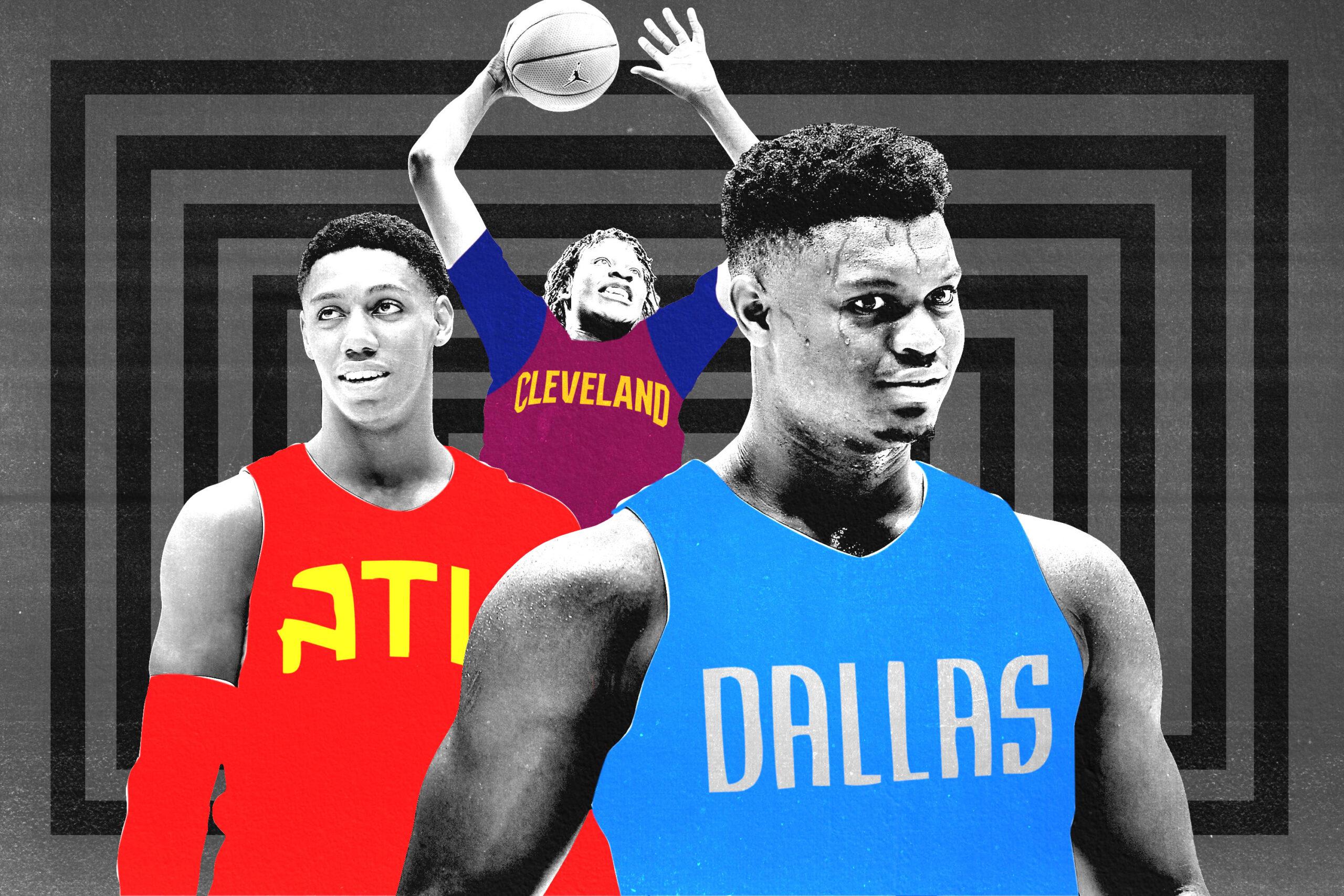
The college basketball season is here, but it’s never too early to start dreaming ahead to June. To celebrate the occasion, our NBA draftniks of The Corner 3 (formerly known as Draft Class!) are pairing some of their favorite prospects in the draft with teams in dire need of their talents.
Atlanta Hawks: R.J. Barrett (Guard/Forward, Duke)
Kevin O’Connor: R.J. Barrett is the most complete prospect in his draft class at this stage of the evaluation process. There’s little evidence that trend won’t continue. No one in NBA circles questions Barrett’s work ethic, and he’s being groomed for long-term success. Canadian Basketball invests heavily in his training and development by having a physical therapist travel with him everywhere. Barrett is worth it: The 6-foot-7 wing already led Team Canada to its first gold medal at the FIBA U19 World Cup in 2017 against Team USA. He has the potential to be the pro star that Canada wished Andrew Wiggins would be.
Barrett can serve as a go-to scorer or a playmaker, and he has both the body and mind-set to be an effective multi-positional defender, but he’s still working to gain consistency on his jumper. At the next level, he’d be best served in a system that’s built to employ multiple attackers, like the Hawks. Trae Young is a stellar passer who can create offense for himself off the dribble. Barrett’s knack for cutting and slashing would make him a favorite target for Young. But Young can also thrive off screens with a costar like Barrett, who can return the playmaking favor.
Atlanta’s style of play is also a fit. Barrett flourishes in the open court; the Hawks are tied for quickest possession time in the NBA, per Inpredictable. Barrett has an unusual blend of size, speed, and fluid ballhandling, and he can occasionally look like a much smaller version of Giannis Antetokounmpo when he’s dribbling in the open floor. Barrett has a lot to prove to cement himself as the no. 1 pick. But it won’t be long before his name is called. The Hawks could be bad enough to have a chance at the rising Canadian star.
Dallas Mavericks: Zion Williamson (Forward/Center, Duke)
Jonathan Tjarks: The most hyped prospect in last year’s draft and the most hyped prospect in this one could be a match made in heaven. Luka Doncic needs a young pick-and-roll partner in Dallas, and he would rack up a lot of assists throwing lobs to Zion. The Mavs brought in DeAndre Jordan to be that guy this season, but he’s not a long-term answer at the position. Zion offers youth and out-of-this-world athleticism, as well as more perimeter-oriented skills like ballhandling and passing.
Zion and Doncic would be a fascinating pair of bookends in Rick Carlisle’s multiple ball handler offensive system, and their development together would make Dallas one of the most captivating teams in the league. Doncic played well as a rookie, but there just isn’t enough talent around him for the team to be relevant. Dallas will get its first-round pick next season only if it’s in the top five, but it’s certainly playing like a team who could be in the running for a high lottery pick. As a Mavs fan, I’m feeling greedy. Let’s make this happen.
Cleveland Cavaliers: Bol Bol (Center, Oregon)
Danny Chau: Life makes fools of us all. I, for one, did not foresee the Cavaliers being the worst team in the NBA, even with the departure of a certain someone. Kevin Love’s extended absence and a strange, passive-aggressive freeze-out of the team’s lottery selection won’t help matters, and there’s a chance this is just who the Cavaliers are. If that’s the case, the Cavs will have their pick of the Duke trio in their search for a new franchise savior. But part of me feels that the team still isn’t nearly as bad as they’ve shown after 10 games. Should the Cavaliers drop out of the top five, the Cavs should be looking at players with home run potential. Bol Bol could be one of those players in the later stages of the lottery.
As the giants of the youth basketball circuit continue to explore their limits on offense, players like Bol might become more commonplace than the anomalies they appear to be today. Bol is a player with Rudy Gobert’s dimensions, except he’s also arguably one of the best shooters in the draft class. He’s not exactly explosive, but is a strangely mesmerizing ball handler for his size, which makes him a threat to attack closeouts from out behind the arc or and shoot off the dribble. We’ve retired the “unicorn” label for a certain type of skilled big man, but players like Bol will still stand out in their uniqueness. He’s a walking Mad Libs of NBA skill sets.
Phoenix Suns: Quentin Grimes (Guard, Kansas)
Tjarks: The Suns probably don’t need any more lottery picks now that they are on (what they hope is) the tail end of a rebuild that has stretched out for almost the entire decade. The abrupt preseason firing of GM Ryan McDonough means it’s unclear who will be making the decisions for Phoenix, and notoriously impatient owner Robert Sarver could push to trade the pick for instant help.
Grimes, one of the most impressive prospects I saw in a week of scrimmages leading up to the Nike Hoop Summit last April, would make a lot of sense if they end up keeping the pick. At 6-foot-5 and 210 pounds, the 18-year-old is already built like an NBA guard. He has the physical tools to hold up on defense next to Devin Booker, and he’s polished enough to play on or off the ball next to the Suns’ franchise player. Phoenix doesn’t need any more projects. They need someone who can come in and contribute right away. Few teenage guards are more equipped for that than Grimes.
Oklahoma City Thunder: De’Andre Hunter (Forward, Virginia)
O’Connor: Every team in the NBA could use a player like De’Andre Hunter. He’s 6-foot-7 and 225 pounds with a 7-foot-2 wingspan, and has the game to match his impressive physical makeup. It starts with defense with Hunter. The 20-year-old defended every position as a redshirt freshman last season at Virginia. He can slide laterally against quicker guards, and has the strength to contain larger wings and even some bigs. Hunter could be used across positions in an NBA lineup, including as a super small-ball 5 for limited minutes because he isn’t afraid to battle for rebounds.
On offense, Hunter realistically projects as more of a role player. He’s a solid spot-up shooter who hit 38.2 percent of his 3s last season, and he can attack off the dribble on straight-line drives. He needs to significantly improve his handle to shake and bake against high-level pro defenders, but he’s shown flashes of dynamic play when hitting midrange pull-ups and finishing against length inside.
Hunter could end up resembling Andre Roberson but with a 3-pointer. That’s why we have him slotted in as an intriguing fit for the Thunder. After starting the season 0-4, Oklahoma City has won five straight games. But it wouldn’t be the worst thing in the world if they found themselves in a position to select a better prospect (whether by record or by trade). Hunter’s defensive prowess and offensive upside makes him a perfect fit next to Russell Westbrook and Paul George, and the right gamble for Sam Presti to strengthen the Thunder.
Orlando Magic: Darius Garland (Point guard, Vanderbilt)
Chau: Orlando has stuck to a very particular set of standards in the draft since John Hammond took over as GM in May 2017, exclusively nabbing players with remarkable wingspans relative to their position. Length is the great equalizer, a way to widen one’s margin for error, especially on the defensive end. The Magic, in theory, are developing a floating fortress of limbs. In practice, they’re much less intriguing. All that length doesn’t mean anything if the ball can’t find its way into the right hands.
This could be the year the Magic deal less in the abstract. The heart of their problem is simple: The Magic have the most dire point guard rotation in recent NBA history. In the 6-foot-3 Garland, the team would be going against type, but they’d actually be targeting their biggest weaknesses. Garland is the best point guard prospect in the 2019 class, and a player who mirrors CJ McCollum’s growth and all his strengths and weaknesses, but on an accelerated timeline. Like CJ, he was a scrawny, 5-foot-something guard with undeniable offensive talent who grew into a 6-foot-3 frame. But unlike McCollum, Garland is doing it as an elite recruit, and he likely won’t have to spend four years at Vanderbilt.
At some point, the Magic will have to find their point guard of the future, whether it’s through throwing bags at Terry Rozier or Spencer Dinwiddie over the summer, or through the draft. Should they fall out of the top six, Garland would be worth a look.

